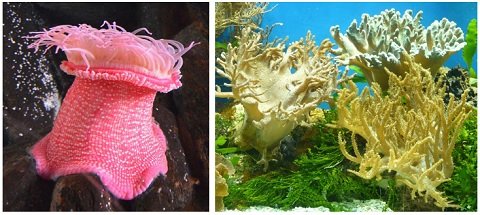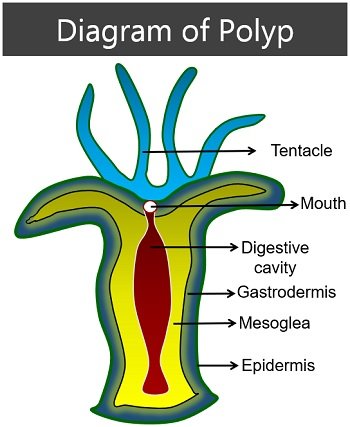The difference between polyp and medusa relies upon motility and shape. Members of the phylum Cnidaria have two different forms of individuals or zooids (polyp and medusa). Polyps are the sessile or fixed individuals, while medusae are motile or free-swimming zooids.
Polyps appear more or less cylindrical, whereas medusae appear umbrella-shaped. Cnidarians can exist as polyps or medusae as adults and planulae as larvae. The majority of members belonging to the phylum Cnidaria exhibit polymorphism.
Polymorphism is a property through which organisms exhibit more than one type of individual in their life cycle, which are structurally and functionally different. Some Cnidarians have both the individuals (polyp and medusa) during their life cycle.
Cnidarians of the class Anthozoa, only have a polyp body form. But, hydrozoans, scyphozoans, and cubozoans alternate generations between polypoid and medusoid body forms.
This post highlights the key differences between polyp and medusa, along with the comparison chart. You will also get to know the definition, examples and modifications between the two.
Content: Sepals Vs Petals
Comparison Chart
| Property | Polyp | Medusa |
|---|---|---|
| Meaning | A polyp is one of the forms found in the members of Cnidarians with a tubular body and sessile lifestyle | A medusa is one of the forms found in the members of Cnidarians with a saucer-shaped body and free-floating lifestyle |
| Motility | Polyps are non-motile, sessile, or fixed zooids | Medusae are motile or free-swimming organisms |
| Shape | They appear more or less cylindrical shape with a long stalk | They appear umbrella-like with a reduced stalk |
| Location | Polyps are attached to the rocks underwater | Medusae are found in open waters |
| Adaptation | They are adapted for a sessile or sedentary life | They are adapted for a floating life |
| Body structure | Simple (body contains a cylindrical trunk and a flattened oral disc) | Complex (body comprises a central bell and numerous marginal tentacles) |
| Mesoglea | Polyps have a poorly developed mesoglea | Medusae have a highly developed mesoglea |
| Manubrium | Absent | Medusa of the class “Hydrozoa” comprises a tube-like manubrium that hangs down from the bell |
| Mouth | Polyp has a single circular and terminal mouth | Medusa has a four-sided mouth present downwards or at the lower end of the hanging manubrium |
| Tentacles | Tentacles surround the mouth as a ring of tentacles | Tentacles surround a central bell and hang downwards at the margin |
| Gastrovascular cavity | It is simple without radial and circular canals | It has four radial canals and one circular canal |
| Nerve cord | Absent (Polyps are unable to move on their own) | Present (Medusae are able to move on their own) |
| Sense organs | Absent | Medusae have eight sense organs called statocysts and photoreceptors |
| Velum | Absent | Present |
| Gonads | The majority of polyps lack sex organs or gonads, but a few may produce gonads | Medusa has four gonads on radial canals |
| Evolution | They are primitive | They are itself evolved from polyp |
| Functional role | Polyps feed and protect the colony | Medusa participates in sexual reproduction and distribution of species |
| Mode of reproduction | They mainly reproduce asexually by budding or sexually by spawning following the release of pheromones | They exclusively reproduce via sexual reproduction by releasing gametes underwater |
| Examples | Hydra, Corals, Sea anemones etc. | Jellyfishes |
Definition of Polyp
Polyps are individuals having a tubular body shape with a free upper end and fixed bottom end. They can be solitary (like sea anemones) or colonial (as in corals).
Hydrozoa is the class that only includes polyps with a simple body organization as in hydra. In contrast, Anthozoan polyps (like corals and sea anemones) have a complex body organization.
Anthozoans have a tubular stomodaeum that extends from the mouth down into the gut. They reproduce asexually by budding.
But sometimes, polyps are associated with the sexual generation, in which they modify into medusae.

Definition of Medusa
Medusae are individuals that appear more of an umbrella or bell shape, with the mouth and tentacles hanging down. They are free-swimming animals that float along water currents by rhythmic muscular contractions of the bell. A medusa represents a typical body plan of jellyfishes.
Three classes (Hydrozoa, Scyphozoa, and Cubozoa) of the phylum Cnidaria alternate in their life cycles. Members belonging to such classes switch between polypoid and medusoid body forms.
In the members of the class Scyphozoa, the population of medusa predominates. In contrast, the polyp population predominates in hydrozoans and Cubozoans.

Polyp produces the jellyfish-shaped medusae asexually, and medusae produce the sperm and eggs. The fusion of sperm and egg turns into a zygote that later develops into Planula larvae.
Planula larvae settle on a solid surface in polypoid forms. They can bud off into polyps via asexual budding. But, the planula larva may transform directly into the medusa in a few Cnidarians.
Structure of Polyp
The body wall of a polyp has an outer ectoderm layer and an inner endoderm layer. A thin, gelatinous layer called mesoglea is present between these two layers. The outer and inner layers secrete mesoglea that contain skeletal elements. The body of a polyp has two distinct ends.

Upper end
- It remains free, i.e. not attached to any surface.
- Many extensible tentacles surround the mouth in the upper end.
- Tentacles appear as finger-like projections that capture prey by stinging structures called nematocytes.
Lower end or Blind end
- It is always attached to the substratum, for which polyps are the sessile organisms.
- The basal plate is the attachment region at the base of the animal.
Trunk
- A long tubular trunk is present between the upper and lower ends.
- It contains a coelenteron or gastrovascular cavity responsible for digestion and circulation. Gastrodermis lines a gastrovascular cavity that comprises a single exterior opening. Thus, the food from the mouth and wastes excrete from the anus through the same opening.
Structure of Medusa
The body wall of a medusa also has outer ectoderm, inner endoderm and a thick mesoglea in between. The body of a medusa has a central bell and marginal tentacles.
Central Bell
- Hydrozoans comprise a stalk-like manubrium that hangs down from the centre of the bell. The manubrium bears the mouth at its tip.
- The mouth is present underside the central bell. It opens into the enteron that connects with radial canals extending to the margin of the central bell. Many hollow tentacles bearing nematocysts encircle the mouth.
- The mouth opens into the gastrovascular cavity that exists as a branched network of canals.
- Scyphozoans have nerve cells over a nerve net. A large nerve net regulates swimming. In comparison, a small nerve net controls feeding and spasm response. Rhopalia exists as a cluster of sensory organs, present at the edge of the bell.
- Jellies have a ring of muscles over the dome of a bell. These muscles provide the contractile force required to swim through water. Also, they help in drawing food from the water.
- Scyphozoans have separate sexes, and the gastrodermis is the region forming gonads. They expel gametes through the mouth.

Tentacles
- Medusae have tentacles hanging from the margins of the central bell.
- They contain nettle-like cells or nematocytes that kill the prey (like fish larvae, copepods etc.).
Key Differences Between Polyp and Medusa
- Cnidarians belong to the kingdom “Animalia” and they generally alternate generations between the polyp and medusa stages. Polyp represents the asexual generation, and they have a tubular body and sessile lifestyle. Medusa represents the sexual generation, and they have a saucer shape and a free-floating lifestyle.
- Polyps are adapted for a sessile or sedentary life as they are non-motile, sessile, or fixed zooids that remain attached to the substratum. In contrast, medusae are adapted for a floating life that floats by rhythmic muscle contraction.
- The body organization of polyps is simple (comprise cylindrical trunk and a flattened oral disc). Oppositely, medusae have a complex body structure (contain a central bell and several tentacles).
- The presence of tentacles is a characteristic feature of all cnidarians, which capture food and sense the touch of prey. Tentacles in polyps are present in the form of a ring around the mouth. But, tentacles in medusae surround a central bell and hang downwards at the margin.
- The gastrovascular cavity helps in food digestion and transportation of nutrients. The cavity has only one opening, i.e. food goes in, and waste comes out of that same opening, making it a two-way digestive tract. A gastrovascular cavity in polyps is simple without radial and circular canals. In contrast, the gastrovascular cavity in the medusae has four radial canals and one circular canal.
- Polyps lack sense organs. In contrast, medusae have eight sense organs called statocysts that maintain the equilibrium and are present at the bases of eight adradial tentacles.
- Medusa has four gonads on radial canals or the oral surface. The majority of polyps lack sex organs except for corals.
- Polyp reproduces asexually or sexually via budding or spawning gametes. Medusa only reproduces via sexual reproduction by spawning gametes (eggs and sperm) underwater.
Conclusion
We can conclude that polyps and medusae are the two different forms found in the group of cnidarians. A significant difference is that polyps are sessile, and medusae are free swimmers.